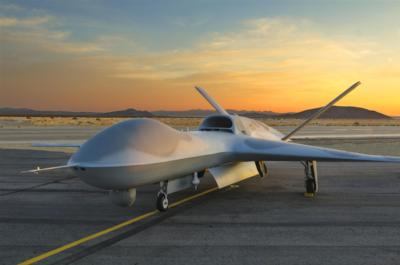Wed, Jan 18, 2023
New Learning Algos Allow Autonomous Thread Avoidance, Environmental Survey
General Atomics (GA-ASI) has continued its work integrating AI 'pilots' on the Open Mission System (OMS) software stack, announcing headway on flight-ready autonomous aircraft in multi-objective testing.

The company advanced its Collaborative Combat Aircraft (CCA) ecosystem with a battery of test missions with artificially intelligent (AI) pilots, evaluating their ability to undergo collaborative combat missions. The flights took place at General Atomics' Desert Horizons flight operations facility in El Mirage, California. In it, a company-owned Avenger UAV was paired with “digital twin” aircraft to autonomously conduct Live, Virtual, and Constructive (LVC) multi-objective collaborative combat missions, putting the digital wingmen through their paces as hands-off combat assets. Throughout the flights, General Atomics sought to enhance the capabilities of its AI systems to "make decisions under dynamic and uncertain
real-world conditions".
As is always the case in software, however, it's much easier said than done. The company's novel Reinforcement Learning (RL) architecture leans heavily on the software industry's ever-present "agile methodology" and a suite of industry tools like Docker and Kubernetes to develop an operationally relevant learning algorithm. So far, their Reinforcement Learning software has demonstrated a few promising behaviors, being able to fly both a live and virtual Avenger simultaneously.

While doing so, a single RL agent was able to chase a target while avoiding threats. A hierarchical RL agent was able to collate sensor data and select appropriate courses of action while in flight, demonstrating the "AI pilot"'s ability to act on real-time information without human input. While performance has largely been suitable to basic threat avoidance and route mapping, General Atomics expects to see compounding benefits as additional AI pilot data is fed into their 'rapid retaining process' for analysis and reuse.
“The concepts demonstrated by these flights set the standard for operationally relevant mission systems capabilities on CCA platforms,” said GA-ASI Senior Director of Advanced Programs Michael Atwood. “The combination of airborne high-performance computing, sensor fusion, human-machine teaming, and AI pilots making decisions at the speed of relevance shows how quickly GA-ASI’s capabilities are maturing as we move to operationalize autonomy for CCAs.”
More News
Aero Linx: International Federation of Airworthiness (IFA) We aim to be the most internationally respected independent authority on the subject of Airworthiness. IFA uniquely combi>[...]
Ultrahigh Frequency (UHF) The frequency band between 300 and 3,000 MHz. The bank of radio frequencies used for military air/ground voice communications. In some instances this may >[...]
A Few Questions AND Answers To Help You Get MORE Out of ANN! 1) I forgot my password. How do I find it? 1) Easy... click here and give us your e-mail address--we'll send it to you >[...]
From 2019 (YouTube Edition): Learning To Paint Without Getting Any On Your Hands PPG's Aerospace Coatings Academy is a tool designed to teach everything one needs to know about all>[...]
Also: Sustainable Aircraft Test Put Aside, More Falcon 9 Ops, Wyoming ANG Rescue, Oreo Cookie Into Orbit Joby Aviation has reason to celebrate, recently completing its first full t>[...]
 ANN's Daily Aero-Linx (05.06.25)
ANN's Daily Aero-Linx (05.06.25) ANN's Daily Aero-Term (05.06.25): Ultrahigh Frequency (UHF)
ANN's Daily Aero-Term (05.06.25): Ultrahigh Frequency (UHF) ANN FAQ: Q&A 101
ANN FAQ: Q&A 101 Classic Aero-TV: Virtual Reality Painting--PPG Leverages Technology for Training
Classic Aero-TV: Virtual Reality Painting--PPG Leverages Technology for Training Airborne 05.02.25: Joby Crewed Milestone, Diamond Club, Canadian Pilot Insurance
Airborne 05.02.25: Joby Crewed Milestone, Diamond Club, Canadian Pilot Insurance




